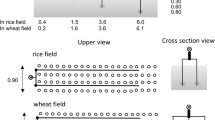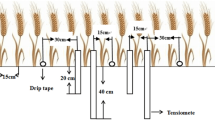Summary
The effects of frequent and shallow soil wetting by surface drip irrigation on root growth, morphology, and location, and their impact on plant sensitivity to irrigation management were studied in cotton (Gossypium hirsutum L.). Daily drip irrigation, which wetted the 0 to 40-cm soil depth, encouraged root development mainly around the drippers. Water extraction took place mostly from 0 to 20 cm below the drippers, where the roots were concentrated. Shallowness of root growth was not altered by the expansion and deepening of the wetted soil zone which resulted from an increase in amount of irrigation water. The shallow and restricted root system was characterized by a high fraction of thin roots (less than 1 mm dia.) which comprised almost 90% of the root dry matter. Root proximity to the drippers and the limited amount of water in the rooted soil led to a sensitive and quick response of the plants to small amounts of irrigation. A supply of 1.0 mm H2O given at midday to 70 day-old plants resulted in a leaf water potential (Lψ w) increase from −1.64 to −1.32 MPa over a 20-min period. This amount of irrigation comprised 15% of the average daily quantity. A 24 h delay in irrigation to 80 dayold plants was enough to decrease Lψ w from −1.41 to −2.42 MPa. This decrease was caused by a soil water deficit of less than 6 mm H2O. Extending the irrigation delay to 72 h affected yield and earliness, although the deficient amount of water was supplied over the several days after the treatment. A strong response to minor, but continuous, differences in the daily irrigation amount was detected. Differences in irrigation of less than 1 mm H2O per day applied during the whole growth season substantially affected Lω w, yield and earliness. It was concluded that the establishment of a shallow and restricted root system resulted in strong dependence of the plants on frequent and sufficient supply of water, and temporary minor changes in irrigation affected plant water status and productivity.
Similar content being viewed by others
References
Basset DM, Stokton JK, Dickens WL (1970) Root growth of cotton as measured by 32P uptake. Agron J 62:200.
Bierhuizen JF (1961) Plant growth and soil moisture relationship. UNESCO Arid Zone Res 16: 309.
Bruce RR (1965) Cotton row spacing as it affects soil water utilization and yield. Agron J 57: 319.
Carmi A, Plaut Z (1982) A new agrotechnique for control of cotton growth and earliness of yield based upon drip irrigation system. Belt Cot Prod Res Con Las Vegas, p 58.
Constable GA, Hearn AB (1981) Irrigation for crops in a subhumid environment. VI Effect of irrigation and nitrogen fertiliz- er on growth, yield and quality of cotton. Irrig Sci 3:17.
Cullen PW, Turner AK, Wilson JH (1972) The effect of irrigation depth on root growth of some pasture species. Plant and Soil 37:345.
Drew MC (1979) Root development and activities. In: Perry RA, Goodall DW (eds) Arid-land ecosystems: structure, functioning and management, Vol 1. Cambridge University Press, Cambridge, p 573.
Grimes DW, Dickens WL, Yamada H (1978) Early season water management for cotton. Agron J 70: 1009.
Hodgson AS, Constable GA, Duddy GR, Daniells IG (1990) A comparison of drip and furrow irrigated cotton on a cracking clay soil. Irrig Sci 11: 143.
Plaut Z, Carmi A, Grava A (1988) Cotton growth and production under drip irrigation restricted soil wetting. Irrig Sci 9:143.
Radin JW, Mauney JR, Kerridge PC (1989) Water uptake of cotton roots during fruit filling in relation to irrigation frequency. Crop Sci 29: 1000.
Taylor HM, Klepper B (1971) Water uptake by cotton roots during an irrigation cycle. Aust J Biol Sci 24: 853.
Turner NC, Hearn AB, Begg JE, Constable GA (1986) Cotton (Gossypium hirsutum L.): Physiological and morphological responses to water deficits and their interrelationship to yield. Field Crop Res 14: 153.
Wind GP (1955) Flow of water through plant roots. Neth J Agric Sci 3: 259.
Author information
Authors and Affiliations
Rights and permissions
About this article
Cite this article
Carmi, A., Plaut, Z., Heuer, B. et al. Establishment of shallow and restricted root systems in cotton and its impact on plant response to irrigation. Irrig Sci 13, 87–91 (1992). https://doi.org/10.1007/BF00193985
Received:
Issue Date:
DOI: https://doi.org/10.1007/BF00193985




